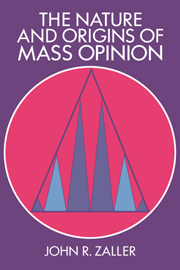Book contents
- Frontmatter
- Contents
- List of tables and figures
- Preface
- 1 Introduction: The fragmented state of opinion research
- 2 Information, predispositions, and opinion
- 3 How citizens acquire information and convert it into public opinion
- 4 Coming to terms with response instability
- 5 Making it up as you go along
- 6 The mainstream and polarization effects
- 7 Basic processes of “attitude change”
- 8 Tests of the one-message model
- 9 Two-sided information flows
- 10 Information flow and electoral choice
- 11 Evaluating the model and looking toward future research
- 12 Epilogue: The question of elite domination of public opinion
- Measures appendix
- References
- Index
2 - Information, predispositions, and opinion
Published online by Cambridge University Press: 05 June 2012
- Frontmatter
- Contents
- List of tables and figures
- Preface
- 1 Introduction: The fragmented state of opinion research
- 2 Information, predispositions, and opinion
- 3 How citizens acquire information and convert it into public opinion
- 4 Coming to terms with response instability
- 5 Making it up as you go along
- 6 The mainstream and polarization effects
- 7 Basic processes of “attitude change”
- 8 Tests of the one-message model
- 9 Two-sided information flows
- 10 Information flow and electoral choice
- 11 Evaluating the model and looking toward future research
- 12 Epilogue: The question of elite domination of public opinion
- Measures appendix
- References
- Index
Summary
Every opinion is a marriage of information and predisposition: information to form a mental picture of the given issue, and predisposition to motivate some conclusion about it. The central aim of this book is to show how, across a very wide range of issues, variations in the information carried in elite discourse, individual differences in attention to this information, and individual differences in political values and other predispositions jointly determine the contours of public opinion. The book, thus, is most crucially about the relationship among information, predispositions, and opinion.
The present chapter introduces and defines these key terms, examines some critical problems associated with their study, and shows in a preliminary way how they relate to one another. In so doing, it develops the intuitions behind the more technical core of the book, which begins in Chapter 3.
INFORMATION AND ELITE DISCOURSE
To an extent that few like but none can avoid, citizens in large societies are dependent on unseen and usually unknown others for most of their information about the larger world in which they live. As Walter Lippmann wrote in his classic treatise, Public Opinion (1922/1946),
Each of us lives and works on a small part of the earth's surface, moves in a small circle, and of these acquaintances knows only a few intimately. Of any public event that has wide effects we see at best only a phase and an aspect. … Inevitably our opinions cover a bigger space, a longer reach of time, a greater number of things, than we can directly observe. […]
- Type
- Chapter
- Information
- The Nature and Origins of Mass Opinion , pp. 6 - 39Publisher: Cambridge University PressPrint publication year: 1992
- 1
- Cited by

